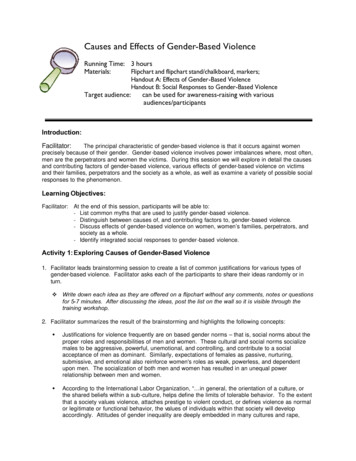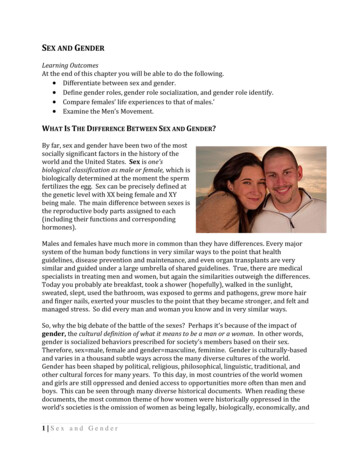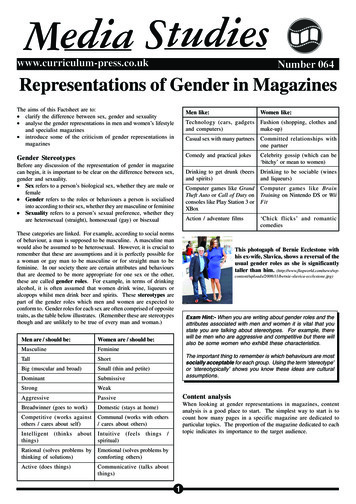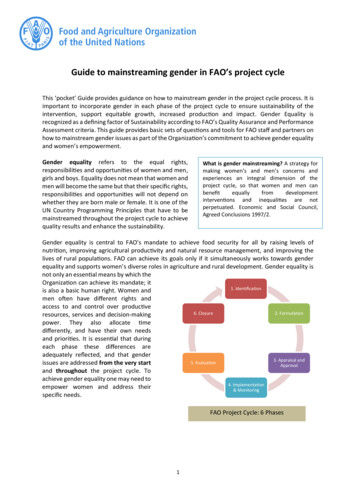
Transcription
Causes and Effects of Gender-Based ViolenceRunning Time: 3 hoursMaterials:Flipchart and flipchart stand/chalkboard, markers;Target audience:Handout A: Effects of Gender-Based ViolenceHandout B: Social Responses to Gender-Based Violencecan be used for awareness-raising with tor:The principal characteristic of gender-based violence is that it occurs against womenprecisely because of their gender. Gender-based violence involves power imbalances where, most often,men are the perpetrators and women the victims. During this session we will explore in detail the causesand contributing factors of gender-based violence, various effects of gender-based violence on victimsand their families, perpetrators and the society as a whole, as well as examine a variety of possible socialresponses to the phenomenon.Learning Objectives:Facilitator:At the end of this session, participants will be able to:- List common myths that are used to justify gender-based violence.- Distinguish between causes of, and contributing factors to, gender-based violence.- Discuss effects of gender-based violence on women, women’s families, perpetrators, andsociety as a whole.- Identify integrated social responses to gender-based violence.Activity 1: Exploring Causes of Gender-Based Violence1. Facilitator leads brainstorming session to create a list of common justifications for various types ofgender-based violence. Facilitator asks each of the participants to share their ideas randomly or inturn.v Write down each idea as they are offered on a flipchart without any comments, notes or questionsfor 5-7 minutes. After discussing the ideas, post the list on the wall so it is visible through thetraining workshop.2. Facilitator summarizes the result of the brainstorming and highlights the following concepts:wJustifications for violence frequently are on based gender norms – that is, social norms about theproper roles and responsibilities of men and women. These cultural and social norms socializemales to be aggressive, powerful, unemotional, and controlling, and contribute to a socialacceptance of men as dominant. Similarly, expectations of females as passive, nurturing,submissive, and emotional also reinforce women's roles as weak, powerless, and dependentupon men. The socialization of both men and women has resulted in an unequal powerrelationship between men and women.wAccording to the International Labor Organization, “ in general, the orientation of a culture, orthe shared beliefs within a sub-culture, helps define the limits of tolerable behavior. To the extentthat a society values violence, attaches prestige to violent conduct, or defines violence as normalor legitimate or functional behavior, the values of individuals within that society will developaccordingly. Attitudes of gender inequality are deeply embedded in many cultures and rape,
domestic assault and sexual harassment can all be viewed as a violent expression of the culturalnorm ." Source: Chapell D. and Di Martino V., 1998. Violence at Work , Geneva, ILO.wThere are many myths about gender-based violence that attempt to explain or justify it. Commonmyths include:Prior to the exercise, prepare a flipchart with the myths written on it for the participants’ referencewüThe perpetrators of violence are a minority group of mentally ill men;üPoverty or war lead to attacks on and abuse of women;üViolence against women is caused by substance abuse, such as drugs and alcohol;üViolence against women is an inevitable part of male-female relations;üViolence against women is an inherent part of maleness, or a natural expressionof male sexual urges.Such views lead to a perception that gender-based violence is rare or exceptional, and/or that it iscaused by factors outside of men’s control. They place onus on women to ensure that theyminimize the chances of their behavior instigating violence.3. Facilitator gives a mini-lecture on causes of gender-based violence emphasizing the following ideas:wWhat causes violence against women? Increasingly, researchers are using an “ecologicalframework” to understand the interplay of personal, situational, and sociocultural factors thatcombine to cause gender-based violence (Population Reports/CHANGE, Volume XXVII, No. 4,December 1999). In this model, violence against women results from the interaction of factors atdifferent levels of the social environment.Prior to the exercise, prepare a flipchart with the ecological model of factors associated with genderbased violence. Refer participants to the flipchart while explaining the model.SocietyCommunityü Norms grantingü Poverty, low socio-men control overfemale behaviorü Acceptance ofviolence as a wayto resolve conflictü Notion of masculinitylinked to dominance,honor and aggressionü Rigid gender roleseconomic status,unemploymentü Associating withpeers who condoneviolenceü Isolation of womenand familyRelationshipü Marital conflictü Male control ofwealth anddecision-making in thefamilyIndividual Perpetratorü Witnessing marital violenceas a childü Absent or rejecting fatherü Being abused as a childü Alcohol use
Source: Heise, L. Violence Against Women: An integrated, ecological framework , 1998, cited in PopulationReports/CHANGE, Volume XXVII, No. 4, December 1999, available at http://www.jhuccp.org/pr/l11edsum.stm.wThe model can best be visualized as four concentric circles. The innermost circle represents thebiological and personal history that affects an individual’s behavior in his/her relationships. Thesecond circle represents the immediate context in which gender-based violence takes place—frequently the family or other intimate or acquaintance relationship. The third circle represents theinstitutions and social structures, both formal and informal, in which relationships are embedded—neighborhood, workplace, social networks, and peer groups. The fourth, outermost circle is theeconomic and social environment, including cultural norms.wA wide range of studies suggest that several factors at each of these levels, while not the solecause, may increase the likelihood of gender-based violence occurring (studies cited in PopulationReports/CHANGE, Volume XXVII, No. 4, December 1999):²²²²At the individual level these factors include the perpetrator being abused as a child orwitnessing marital violence in the home, having an absent or rejecting father, and frequentuse of alcohol.At the level of the family and relationship, cross-cultural studies have cited male control ofwealth and decision-making within the family and marital conflict as strong predictors ofabuse.At the community level women's isolation and lack of social support, together with male peergroups that condone and legitimize men's violence, predict higher rates of violence.At the societal level studies around the world have found that violence against women ismost common where gender roles are rigidly defined and enforced and where the concept ofmasculinity is linked to toughness, male honor, or dominance. Other cultural normsassociated with abuse include tolerance of physical punishment of women and children,acceptance of violence as a means to settle interpersonal disputes, and the perception thatmen have “ownership” of women.wAn ecological approach to gender-based violence argues that no one factor alone “causes”violence but rather that a number of factors combine to raise the likelihood that a particular man ina particular setting may act violently toward a woman.wIn the ecological framework, social and cultural norms-such as those that assert men’s inherentsuperiority over women – combine with individual-level factors – such as whether a man wasabused himself as a child – to determine the likelihood of gender-based violence. The more riskfactors present, the higher the likelihood of violence.v Facilitator should be aware of the distinction between causes and contributing factors andarticulate this to participants (i.e. low economic status, alcohol, narcotics all contribute togender-based violence but themselves are not causes)wIt is important to remember that psychological explanations for gender-based violence (i. e.witnessing marital violence as a child, having an absent or rejecting father, or being abused as achild) often fail to appreciate the role of wider inequalities in the relations between women andmen, and the need to transform these. It is not simply the case that if one sees or experiencesviolence as a child, one will in turn abuse others. Studies emphasize that girls are three to sixtimes more likely to experience sexual abuse than boys, yet the vast majority of sexual abuse isperpetrated by male, not female, adults (e.g. Francine Pickup, in Ending Violence Against Women: AChallenge for Development and Humanitarian Work , Oxfam GB 2001).wAt the other extreme, the explanation of violence against women solely as the result of men’sexperience of external factors (i. e. poverty, conflict, rapid economic or political change), fails to
take into account that gender-based violence cuts across socio-economic boundaries. Whileevidence from women themselves in many different contexts indicates that poverty and crisisexacerbate violence against women, in particular domestic violence, poverty is not in itself thecause of violence against women. Rather, it is one of main factors that may aggravate orincrease the violence that already exists. The fact that not all men in poor households are violentindicates that poverty is an insufficient explanation of violence. Exaggerating the role of poverty,in fact, negates people’s agency in making choices about the way they react to factors outside oftheir control.Likewise, conflict and rapid social or economic change affect the extent of gender-based violencein a society, but they do not cause it. Existing rates of violence against women do often increaseduring times of social instability, and new patterns of abuse can be triggered. Situations likemen’s unemployment and women’s entry into the workforce during times of economicrestructuring, or the lack of opportunities for demobilized soldiers after a war, may pose achallenge to men’s sense of themselves as powerful. In contexts where individual men feel theirsense of masculinity and power is threatened, and gender-based violence is condoned in law orin custom, such violence may increase in intensity and frequency, as men struggle to maintain asense of power and control.wThe gender perspective on violence against women shows us that the root cause of violence liesin the unequal power relations between women and men, which ensure male dominance overwomen, and are a characteristic of human societies throughout the world.Activity 2: Exploring Effects of Gender-Based Violence1. Facilitator introduces the activity with the following statement:wwwwWhile women are usually the immediate victims of gender violence, the consequences of genderviolence extend beyond the victim to the society as a whole.Gender violence threatens family structures; children suffer emotional damage when they watchtheir mothers and sisters being battered; two-parent homes may break up, leaving the newfemale heads of household to struggle against increased poverty and negative socialrepercussions.Psychological scars often impede the establishment of healthy and rewarding relationships in thefuture. Victims of gender violence may vent their frustrations on their children and others, therebytransmitting and intensifying the negative experiences of those around them. Children, on theother hand, may come to accept violence as an alternative means of conflict resolution andcommunication. It is in these ways that violence is reproduced and perpetuated.During the exercise that we will conduct next, you will have an opportunity to examine the variouseffects of gender-based violence.2. Facilitator forms small groups of 4-6 participants, distributes flipchart sheets and markers and givesthem the following task:wDiscuss and identify effects of gender-based violence in terms of:Ø Impact on women’s health:Ø PhysicalØ PsychologicalØ Economic and social impact on womenØ Impact on women’s family and dependantsØ Impact on the perpetrators of violenceØ Impact on society
Write the above list on a flipchart sheet so the groups can refer to it.wEach group will be assigned a separate category (or two categories) for discussion. You willhave 25 minutes to complete this task.3. After 25 minutes facilitator reconvenes the entire group and discusses their work using the followingprocess:a.Have one group to report the results of their discussion for the first category of effects, impact onwomen victims of gender-based violence.b.Ask the other groups to add any items they discussed that did not appear on the reporting group’slist.c.Repeat steps a and b, alternating groups until each category has been discussed; end withadding any items missed by all the groups. See Handout A for a comprehensive list.4. Facilitator distributes the Handout A to the group and closes the exercises asking if there are anyquestions.Activity 3: Examining Social Responses to Gender-Based Violence1. Facilitator introduces the idea of various social responses to GBV:wwwOver the last few decades, gender-based violence has been recognized and discussed as apublic, rather than a private problem. As a result, a multitude of potential responses has beenidentified within the state and civil society.There is a variety of approaches to gender-based violence (i.e. human rights, health,development) and they are being integrated to address the problem. Through participation ofmultiple sectors and entire communities in addressing gender-based violence, it is possible toachieve effective prevention and create social networks with ensure that victims of gender-basedviolence receive the care and protection they need.The Pan American Health Organization points out that creating these networks involvesintegrating gender-based violence prevention and care into existing systems and services, as wellas designing new responses. Social responses to gender-based violence fall under severalcategories:Refer the participants to the flipchart prepared prior to the exercise, which lists the following socialresponses:Social Responses to Gender Based Violenceüüüüühealth care servicesvictim assistance servicesworking with perpetratorsexploring masculinitiesmedia information and awarenesscampaignsüüüüüeducationlegal responsescommunity interventionsfaith-based programsinternational conferences andconventions-- Pan American Health Organization, Women, Health and Development Program, Fact Sheet,available at sgbv.pdf.
2. Facilitator divides participants into small groups or pairs that represent each social responses categoryor 2-3 categories (or the most applicable ones). Then the facilitator describes/ distributes a scenarioabout an individual victim, her abuser and her family, and asks the groups to brainstorm possibleappropriate responses/activities from the perspective of their category/categories that would help thevictim. Facilitator allows participants 25 minutes to complete the task.3. After 25 minutes, facilitator reconvenes the entire group and they discuss their work through thefollowing process:a.Groups report back on responses/ activities, taking turns. Facilitator writes down the answers onthe flipchart, under their respective category and adds items that have been missed by all groups.See Handout B for ideas.b.Guided discussion in the large group follows.4. Facilitator distributes Handout B and ends the exercise emphasizing the following points:wwwWe have just identified many activities under various categories of social responses to genderbased violence that could be undertaken to address the problem more effectively. The handoutyou just received contains a complete list and description of social responses.Effective violence prevention as well as the appropriate protection and support of victims requireinterdisciplinary and inter-institutional cooperation as well as a common understanding of thenature and causes of gender-based violence. Prevention, the protection of victims, work withperpetrators and informing the public therefore go hand in hand.In order to create networks between different levels of intervention and to link a complementaryrange of services in the legal, political, psycho-social and medical domains, measures at thepolitical, institutional and civil society levels must be coordinated and there must be agreementabout the nature of gender-based violence.Summary and Closing:Facilitator closes emphasizing the following points:w The root cause of gender-based violence lied in unequal power relations between women andmen. However, a variety of factors on the individual level, the family level, and at the level ofcommunity and society, often combine to raise the likelihood of violence occurring.w The effects of gender-based violence are far-reaching and extend beyond the individual survivor,to the family and society as a whole.w Potential social responses to gender-based violence are most effective when there is a commonunderstanding of the nature and causes of gender-based violence and it is addressed from allangles, through the participation of multiple sectors and entire communities.Questions and Comments:Facilitator should end the session by asking if there are remaining questions or comments related to thismaterial. Keeping track of feedback will allow the facilitator to make useful changes to futurepresentations.Copyright 2003 Minnesota Advocates for Human Rights; available from http://www.stopvaw.org.Permission is granted to use this material for non-commercial purposes. Please use proper attribution.
HANDOUT AEffects of Gender-Based ViolenceThe effects of violence on women vary widely. It depends on the nature of the particular incident, thewoman’s relationship with her abuser, and the context in which it took place. Gender-based violencetypically has physical, psychological, and social effects. For the survivors, these are interconnected.ð The impact on gender-based violence on women’s health:Gender-based violence has been linked to many serious health problems, both immediate and long-term.These include physical and psychological health problems:Ø Physicalü injury,ü disability,ü chronic health problems (irritable bowel syndrome, gastrointestinal disorders, various chronic painsyndromes, hypertension, etc.)ü sexual and reproductive health problems (contracting sexually transmitted diseases, spread ofHIV/AIDS, high-risk pregnancies, etc.)ü deathØ PsychologicalEffects can be both direct/ indirectü Direct: anxiety, fear, mistrust of others, inability to concentrate, loneliness, post-traumatic stressdisorder, depression, suicide, etc.ü Indirect: psychosomatic illnesses, withdrawal, alcohol or drug use.ð Economic and social impact:Ø Rejection, ostracism and social stigma at community level;Ø Reduced ability to participate in social and economic activities;Ø Acute fear of future violence, which extends beyond the individual survivors to other members incommunity;Ø Damage to women’s confidence resulting in fear of venturing into public spaces (this can often curtailwomen’s education, which in turn can limit their income-generating opportunities);Ø Increased vulnerability to other types of gender-based violence;Ø Job loss due to absenteeism as a result of violence;Ø Negative impact on women’s income generating power;ð The impact on women’s family and dependants:Ø Direct effects:ü divorce, or broken families;ü jeopardized family’s economic and emotional developmentü babies born with health disorders as a result of violence experienced by the mother duringpregnancy (i.e. premature birth or low birth weight);ü increased likelihood of violence against children growing up in households where there is domesticviolence;ü collateral effects on children who witness violence at home (emotional and behavioraldisturbances, e.g. withdrawal, low self-esteem, nightmares, self-blame, aggression against peers,family members, and property; increased risk of growing up to be either a perpetrator or a victim ofviolence)
Ø Indirect effects:ü Compromised ability of survivor to care for her children (e.g. child malnutrition and neglect due toconstraining effect of violence on women’s livelihood strategies and their bargaining position inmarriage)ü Ambivalent or negative attitudes of a rape survivor towards the resulting child.ð The impact of violence on the perpetrators:ØØØØsanctioning by community, facing arrest and imprisonment;legal restrictions on seeing their families, divorce, or the break up of their families;feeling of alienation from their families;minimizing the significance of violence for which they are responsible; deflecting the responsibility forviolence onto their partner and failure to associate it with their relationship;Ø increased tension in the homeð The impact of violence on society:Ø burden on health and judicial systemsØ hindrance to economic stability and growth through women’s lost productivityØ hindrance to women’s participation in the development processes and lessening of their contributionØØØØto social and economic development.constrained ability of women to respond to rapid social, political, or economic change.breakdown of trust in social relationshipsweakened support networks on which people’s survival strategies depend.strained and fragmented networks that are of vital importance in strengthening the capabilities ofcommunities in times of stress and upheavalSources:Population Reports/CHANGE, No. 4, Volume XXVII, December 1999, available athttp://www.jhuccp.org/pr/l11edsum.stmPickup, F., Williams, S., Sweetman, C. Ending Violence Against Women: A Challenge for Development andHumanitarian Work, Oxfam GB 2001OutLook: Violence Against Women: Effects on Reproductive Health , Vol.20, No. 1September 2002, available athttp://www.path.org/files/EOL 20-1.pdf.Copyright 2003 Minnesota Advocates for Human Rights; available from http://www.stopvaw.org.Permission is granted to use this material for non-commercial purposes. Please use proper attribution.
HANDOUT BSocial Responses to Gender-Based ViolenceqHealth Care - Training health care providers to recognize and respond to gender-based violence is one of themost important ways of identifying and assisting victims. Not just obstetrician/gynecologists but all health careprofessionals must learn to recognize the signs: hospitals (especially emergency room staff); public and privatehealth clinic staff; general/family practitioners; internists; pediatricians; psychiatrists; nurses and the staff offamily planning clinics. More information: http://www.ippf.org/resource/gbv/ma98/qVictim Assistance Services - These are services created or incorporated to respond to gender-based violence,such as: battered women shelters; homeless shelters; financial assistance programs; women's police stations orservices; victim advocacy programs; rape crisis, domestic violence and suicide prevention hotlines; legalservices; runaway programs; social welfare programs; psychological support services (including individualcounseling and support groups) and teen sexuality programs/health services. More .htm and ort Groups - While support groups can fall under the heading of victim assistance services, they meritspecial mention because they are not always externally organized services. Support groups can be a importantway for victims themselves to organize pro-actively and take charge of their own situation. Beyond emotionalsupport, group members can also provide one another with a sense of security and even, if needed, a place togo. More information: df (see section on support groups).qWorking with Perpetrators - Working with the perpetrators of violence (batterer-intervention programs) hasbeen a controversial and occasionally successful response. While victim assistance services are a useful bandaid to address an existing problem, this approach targets efforts at the source of the problem, attempting tochange violent men's behavior. More information: oring Masculinities - Programs which address masculinities attempt to explore what "makes a man". Thecentral idea is to educate boys from the earliest age that violence (against anyone) is wrong, that the prevailingdefinition of masculinity in any society is not the only alternative, and that even though they are physicallydifferent, girls are entitled to the same rights and opportunities as men. More information:http://www.un-instraw.org/mensroles and http://www.puntos.org.ni and http://www.oneworld.org/cantera/qMedia Information and Awareness Campaigns - The media is a key conduit for making GBV visible,advertising solutions, informing policy-makers and educating the public about legal rights and how to recognizeand address GBV. Newspapers, magazines, newsletters, radio, television, the music industry, film, theatre,advertising, the internet, posters, leaflets, community notice boards, libraries and direct mail are all channels forproviding information to victims and the general public about GBV prevention and available services. Moreinformation: l.htmqEducation - School systems are instrumental to stopping GBV before it starts. Regular curricula, sexualityeducation, school counseling programs and school health services can all convey the message that violence iswrong and can be prevented, suggest alternative models of masculinity, teach conflict-resolution skills andprovide assistance to children/adolescents who may be victims or perpetrators of violence. Integrating GBV as asubject into psychology, sociology, medicine, nursing, law, women's studies, social work and other programsenables providers to identify and tend to this problem. More information:http://www.mincava.umn.edu/courses.asp and http://www.mincava.umn.edu/educ.aspqFaith-Based Programs and Services - Religious counseling, support groups, education programs, studygroups and assistance programs can address GBV with their participants/worshippers. Most religionsemphasize the importance of peace and tolerance. Framing a discussion of GBV in the context of religioustenets is one way to foster awareness and discussion of the problem . It may also be a way to identify and assistvictims who do not feel comfortable talking to a health care provider or police officer. More al Responses - The criminalization of all forms of GBV - dom estic violence, rape, sexual harassment,psychological violence etc. has been an important step in eliminating it. What remains is the consistentapplication of these laws, the implementation of penalties, and a greater focus on rehabilitating convictedperpetrators. Other legal responses to GBV have included: legal aid services; training of police and judicialpersonnel; women's police stations; legal advocacy and lobbying; training of family, criminal, immigration andjuvenile court lawyers and bar association advocacy. More information: http://www.ilj.org/dv/
qInternational Conferences and Conventions - The international community has come together to addressgender-based violence through a variety of conferences, conventions and agreements. Though these do nothave the same binding force as domestic law, international conventions such as the Declaration on theElimination of Violence Against Women can be demonstrative of a state's willingness to acknowledge theproblem of GBV and seek solutions. International conventions also hold states accountable to an internationaland externally monitored standard. International conferences on GBV bring together groups and actors from allover the world, giving them the opportunity to share their own experiences, and learn from others. DEVAW inEnglish: http://www.un.org/documents/ga/res/48/a48r104.htm and in /violence.htmqCommunity Networks and Interventions - A number of studies have shown that involving entire communitiesin recognizing, addressing and working to prevent GBV is one of the surest ways of eliminating it. To beoptimally effective, community networks must bring together all of the responses outlined above, integratingmembers from all sectors of the community: families; businesses; advocacy groups/civil society; public servicessuch as police, fire fighters and medical examiners; social services such as welfare, unemployment, publichousing and health; education; the media and officials from national, state/provincial and local/municipalgovernments. Community interventions must send a clear message about what gender-based violence is, thedifferent forms it can take, why it is wrong and how to prevent it. More .htmSource: Pan American Health Organization, Women, Health and Development Program, Fact Sheet: SocialResponses to Gender-Based Violence, available sesgbv.pdf.Copyright 2003 Minnesota Advocates for Human Rights; available from http://www.stopvaw.org.Permission is granted to use this material for non-commercial purposes. Please use proper attribution.
The innermost circle represents the biological and personal history that affects an individual’s behavior in his/her relationships. The second circle represents the immediate context in which gender-based violence takes place— frequently the family or other intimate or acquaintance relat










